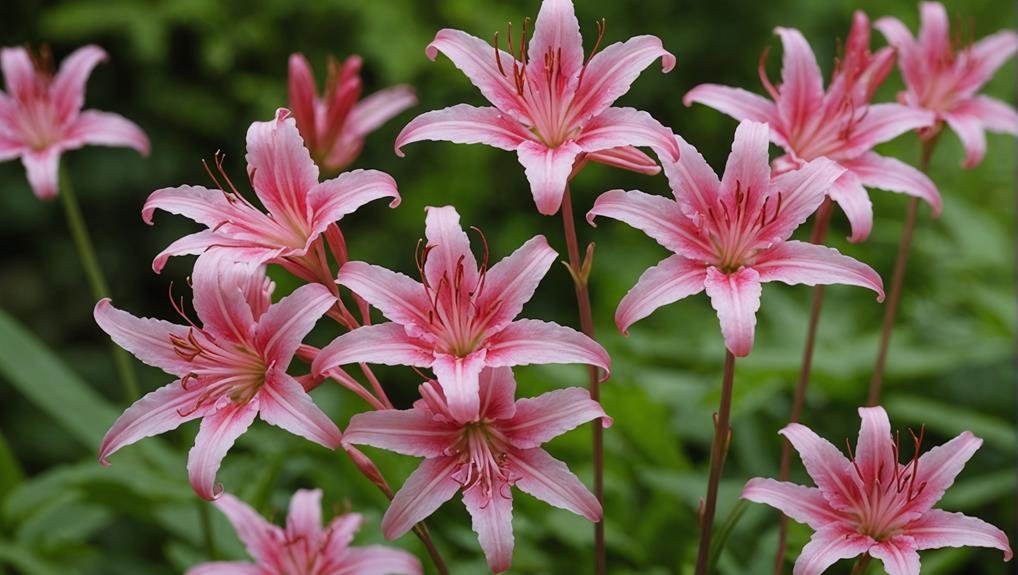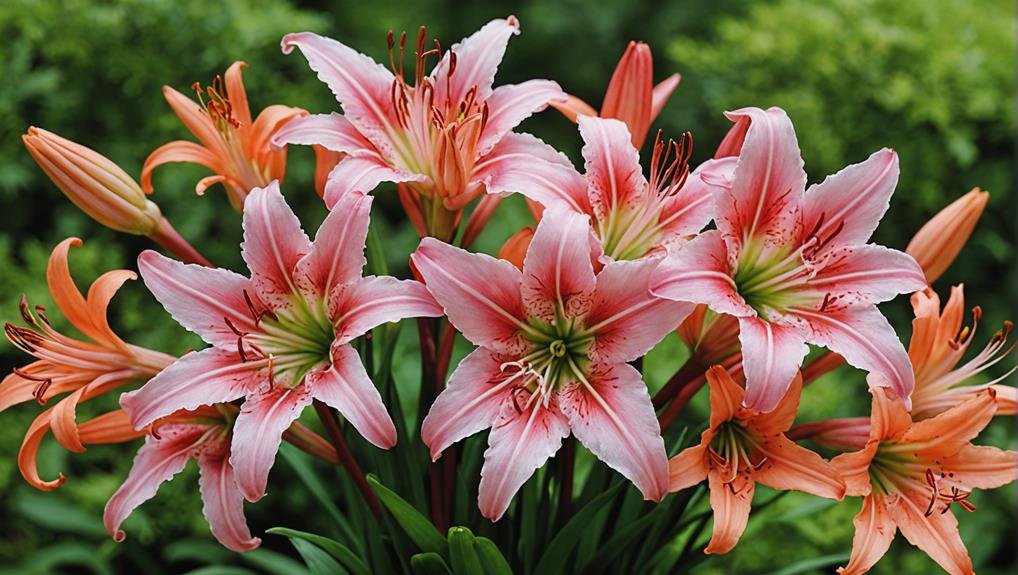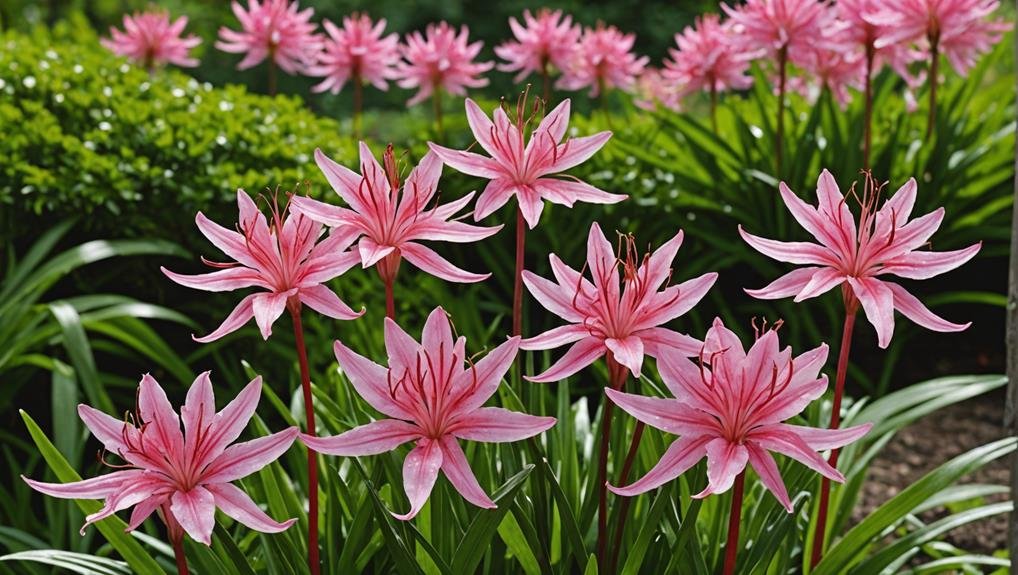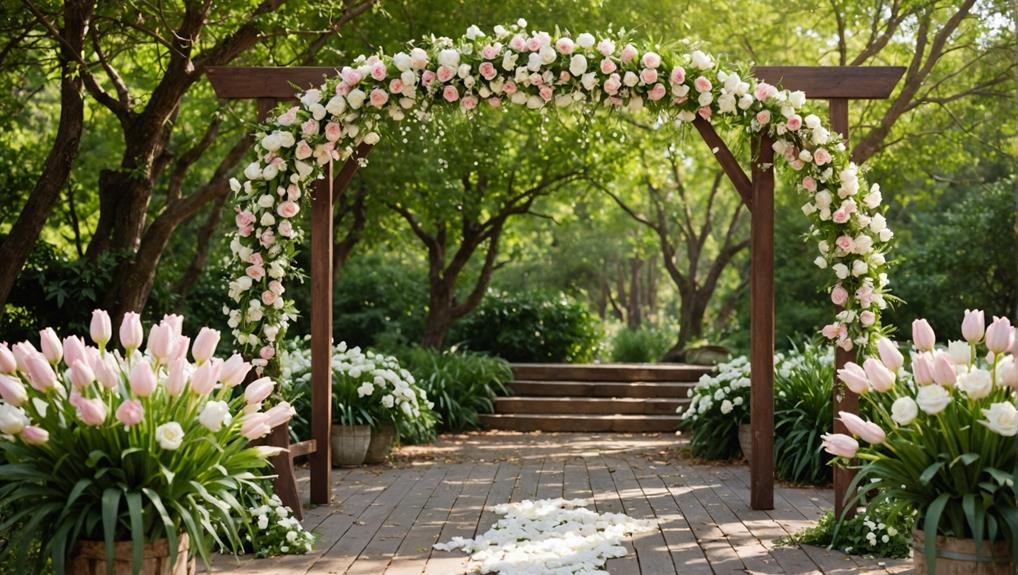In the world of wedding florals, the Nerine stands out as an exquisite choice, known for its delicate, funnel-shaped blooms and vibrant array of colors. Originating from the subtropical regions of South Africa, Nerines bring a unique blend of purity, passion, and romance to any celebration. Their impressive vase life and year-round availability make them an adaptable option for various wedding themes. As we explore the characteristics and significance of the Nerine, its cultural importance and practical applications in weddings become evident, raising intriguing considerations for those planning their special day.
Flower Overview

Originating from South Africa, the Nerine, also known as Guernsey Lily or Jersey Lily, is an enchanting flower renowned for its vibrant hues and ornamental appeal. These flowers are especially favored for their versatility and striking appearance, making them a popular choice for wedding flowers.
Nerines come in an array of alluring colors, including shades of white, red-orange, pink, and crimson, which allows them to complement a variety of wedding themes and floral arrangements.
One of the key advantages of incorporating Nerines into wedding bouquets and decorations is their robust vase life of 10-14 days, ensuring that they remain fresh and visually appealing throughout the event. With a stem length of 40-50 cm, Nerines provide an elegant and elongated structure that integrates well with other flowers, such as parrot tulips, to create stunning, multidimensional floral displays.
When stored at ideal temperatures of 2-4°C and properly hydrated, Nerines maintain their freshness and vibrancy, making them a reliable option for wedding planners. Their ability to blend seamlessly with other wedding flowers while standing out for their unique beauty makes Nerines an excellent addition to any bridal bouquet.
Physical Description
Nerine flowers feature delicate, funnel-shaped blooms that grow atop long, leafless stems. These elegant flowers are often used in wedding bouquets and floral arrangements, providing a touch of sophistication and beauty. Originating from South Africa, nerines are known for their graceful appearance and structural uniqueness. The blossoms are typically arranged in an umbel, creating a starburst effect that adds visual interest to any floral design.
The stems of nerine flowers can reach impressive lengths, ranging from 16 to 26 inches, which makes them ideal for both tall arrangements and cascading bouquets. Their leafless stems offer a minimalist aesthetic that highlights the intricate form of the blooms themselves. With a vase life of 10 to 14 days, nerines are a durable option for events that demand long-lasting floral displays.
Nerines are available year-round, making them a dependable choice for weddings and other special occasions regardless of the season. Their consistent availability and versatility make them a popular choice among florists and event planners. The combination of their striking appearance and sturdy nature ensures that nerine flowers continue to be a favored element in sophisticated floral compositions.
Available Colour Varieties

In addition to their remarkable physical attributes, the available colour varieties of nerine flowers further enhance their appeal in wedding and event floral arrangements. These vibrant blooms come in an array of colours, including white, red-orange, pink, and crimson, making them a versatile choice for various themes and styles. The wide colour range allows for creative and impactful floral combinations, adding bright splashes of colour that can complement any bridal palette.
Nerines are particularly popular in late summer and autumn weddings, aligning perfectly with seasonal pairings that highlight their vivid hues. Their striking colours also lend themselves to symbolic meanings, with each shade conveying different sentiments. For instance, white nerines symbolize purity and elegance, making them ideal for traditional weddings, while crimson and red-orange hues can signify passion and energy, adding a dynamic touch to more modern ceremonies.
- White Nerines: Symbolize purity and elegance; perfect for traditional weddings.
- Crimson and Red-Orange Nerines: Represent passion and energy; ideal for contemporary settings.
- Pink Nerines: Convey romance and joy; suitable for romantic wedding themes.
Commercially cultivated in Australia, nerine blooms are readily available for ornamental displays. When out of season, they can be imported, ensuring their presence in floral arrangements year-round.
Latin Name and Taxonomy
Belonging to the Amaryllidaceae family, the Latin name for the nerine flower is Nerine spp., with common names including Guernsey Lily and Jersey Lily. The taxonomic classification of Nerine reflects its intricate botanical characteristics and evolutionary history. The genus Nerine comprises approximately 30 species, each exhibiting unique floral attributes that contribute to their popularity in ornamental horticulture.
Taxonomic Classification | Botanical Characteristics | Evolutionary History
————————–|————————–|———————-
Amaryllidaceae Family | Vibrant blooms in colors like white, red-orange, pink, and crimson | Derived from the Nereids, sea nymphs in Greek mythology
Nerine spp. | Linear, strap-shaped leaves, and umbels of flowers | Native to South Africa, indicating diverse evolutionary adaptations
Approximately 30 species | Flowers have a distinctive funnel shape with recurved petals | Known for their resilience and adaptability in various climates
The botanical characteristics of Nerine are remarkable, with its vibrant blooms and linear, strap-shaped leaves. These features not only add aesthetic value but also underline the plant's adaptability and resilience. The evolutionary history of Nerine is equally fascinating. Originating from South Africa, these flowers have developed various adaptations to thrive in diverse environments. The name Nerine itself is derived from the Nereids, sea nymphs in Greek mythology, symbolizing the flower's enchanting beauty. This taxonomic and botanical richness makes Nerine a favored choice for wedding bouquets and ornamental displays.
Geographical Origins

Originating from the Cape Province region of South Africa, Nerine flowers are remarkable for their historical significance and cultural connections. Known as Guernsey Lily or Jersey Lily, these names reflect their transportation and cultivation history, particularly in the Channel Islands.
Nerine's climate preferences are rooted in their native habitat, which experiences a Mediterranean climate with wet winters and dry summers. This adaptation allows them to thrive in similar climates around the world, contributing to their widespread botanical distribution and prominence in global horticulture.
The vibrant hues of nerine flowers, ranging from white to crimson, are a testament to their environmental impact, adding vivid splashes of color to floral arrangements and gardens alike.
Several factors highlight the importance of Nerine's geographical origins:
- Historical significance and cultural connections: Their association with the Channel Islands adds a layer of rich history and cultural depth.
- Climate preferences and environmental impact: Adaptations to their native Mediterranean climate enable their cultivation in diverse regions.
- Botanical distribution and horticultural adaptations: Their successful propagation in various climates underscores their adaptability and resilience.
These facets collectively enhance Nerine's charm and utility in wedding floral arrangements worldwide.
Season Availability
Nerine flowers' blooming period from late summer to autumn in Australia makes them particularly sought after for weddings during these seasons. Their availability during these months aligns perfectly with popular wedding themes that embrace vibrant hues and natural beauty. As Nerine flowers are commercially cultivated in Australia, they are readily available for floral arrangements and bouquets, guaranteeing that brides and event planners can incorporate these stunning blooms into their designs without difficulty.
The vibrant colors of Nerine flowers, which include white, red-orange, pink, and crimson, add a bright and cheerful touch to any wedding decor. These colors can be harmoniously integrated into various seasonal trends, enhancing the aesthetic appeal of the event. When selecting Nerine stems for your wedding, it is advisable to choose those with partially open flowers and colored, but not fully open, buds to ensure best freshness and longevity.
To maintain the freshness of Nerine flowers, it is essential to store them in cool rooms at temperatures between 2-4°C. Additionally, using flower food and removing any dried sheaths can help preserve their vase life, which typically ranges from 10 to 14 days. This guarantees that Nerine flowers remain vibrant and beautiful throughout the wedding celebrations.
Growing Conditions

To cultivate Nerine flowers successfully, gardeners must make certain they are planted in well-draining soil with ample sunlight exposure. Ensuring the right soil requirements and sunlight exposure is essential for the best growth of these striking blooms. Nerines thrive in full sun, which aids in producing vibrant flowers and sturdy stems.
In terms of watering frequency, these plants prefer a moderate regimen. It is vital to let the soil dry out between waterings to avoid waterlogged conditions, which can harm the bulbs. Additionally, providing frost protection is crucial in colder climates, as nerines are sensitive to low temperatures. To safeguard them, consider mulching or using frost cloths during winter months.
Regular maintenance, including bulb division, is key to promoting healthy growth and blooming. Dividing the bulbs every few years prevents overcrowding and encourages robust flower production. For those planning to use nerines in wedding arrangements, this practice ensures a steady supply of fresh, beautiful blooms.
- Soil Requirements and Sunlight Exposure: Well-draining soil, full sun.
- Watering Frequency and Frost Protection: Moderate watering, allow soil to dry, protect from frost.
- Bulb Division and Best Growth: Divide bulbs every few years for healthy growth.
Cultural Significance
In various cultures, nerine flowers hold significant symbolic meanings, often associated with beauty, elegance, and resilience. Named after the Nereids, sea nymphs in Greek mythology, nerine flowers carry mythological connections that imbue them with a sense of enchantment and mystique. These mythological connections enhance their appeal, making them a favored choice for those who appreciate the deeper, symbolic meanings of floral selections.
Originating from South Africa, nerine flowers have traditional uses that reflect their vibrant and diverse colors, such as white, red-orange, pink, and crimson. In their native region, they are cherished not only for their striking appearance but also for their symbolic representation of strength and endurance, thriving in harsh conditions and displaying a remarkable resilience. This cultural backdrop adds depth to their selection for various ornamental displays.
The traditional uses of nerine flowers extend to their long-lasting nature, with a vase life of 10-14 days, making them ideal for sustained enjoyment in floral arrangements. Their stem length, ranging from 40-50 cm, ensures they stand out in any setting, further emphasizing their role in cultural and decorative contexts. By recognizing these cultural significances, one can appreciate the rich heritage and beauty that nerine flowers bring to any occasion.
Typical Use in Weddings

Why are nerine flowers a popular choice for wedding bouquets and arrangements?
Nerine flowers are favored for their delicate and elegant appearance, which enhances the beauty of wedding floral designs. Their long stems contribute to their versatility, making them ideal for tall arrangements that add sophistication to any setting. Available in a variety of colors, including reds, oranges, whites/ivories, and pinks, nerines can suit a wide range of wedding themes and color palettes.
Moreover, nerine flowers are available year-round, providing consistent options for both summer and autumn weddings. Their bright hues offer a vibrant touch, making them perfect for:
- Bouquet accents and Table centerpieces: Their striking colors and elegant form make nerines an excellent choice for adding visual interest to bridal bouquets and reception tables.
- Aisle decorations and Boutonniere options: Nerines can line the wedding aisle beautifully and serve as refined boutonnieres for the groom and groomsmen.
- Cake toppers and Hair accessories: Their delicate blooms can adorn wedding cakes and bridal hairstyles, adding a cohesive floral theme throughout the event.
With a vase life of 10-14 days, nerine flowers maintain their beauty throughout the wedding ceremony and reception, ensuring lasting elegance.
Alternative Flower Types
When considering alternative flower types for wedding bouquets and arrangements, several other blossoms also offer unique charm and versatility. For those seeking budget friendly options, carnations and chrysanthemums are excellent choices. These flowers are not only affordable but also available in a wide range of colors, allowing for creative and unique arrangements.
For couples desiring a touch of luxury without the high price tag, alstroemerias and dahlias can be considered. Alstroemerias, known for their longevity and vibrant hues, can add a dynamic element to any bouquet. Dahlias, with their intricate petal structures and rich colors, provide a sophisticated aesthetic that rivals more expensive blooms.
Seasonal alternatives are also worth exploring to guarantee freshness and cost-effectiveness. Tulips and peonies are ideal for spring weddings, bringing a sense of renewal and elegance. For autumn ceremonies, consider incorporating sunflowers or marigolds to align with the seasonal palette and maintain a warm, inviting atmosphere.
Ultimately, selecting the right flowers involves balancing aesthetic appeal with practical considerations such as budget and seasonality. Exploring these alternative flower types can help create stunning wedding arrangements that are both unique and financially sensible.
